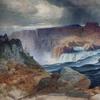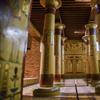John McLaughlin Paintings: Total Abstraction at LACMA
- LOS ANGELES, California
- /
- October 31, 2016

From Nov. 13, 2016 to April 16, 2017, The Los Angeles County Museum of Art (LACMA) presents John McLaughlin Paintings: Total Abstraction, the artist’s first solo retrospective in 20 years. One of the most important Southern California artists of the postwar period, John McLaughlin (1898–1976) created a focused body of geometric paintings that are entirely devoid of any connection to everyday experience and inspired by the Japanese notion of ma (the void). Using a technique of layering rectangular bars on adjacent planes of muted color, McLaughlin created works that provoke introspection by making the viewer, not the artist, their subject. The exhibition is organized chronologically and consists of 52 paintings and a selection of collages and drawings that establish McLaughlin as one of the foremost innovators of total abstraction.
John McLaughlin Paintings is curated by Stephanie Barron, senior curator and head of modern art, and Lauren Bergman, assistant curator in modern art. McLaughlin was included in the now-landmark 1959 exhibition Four Abstract Classicists, organized by the Los Angeles County Museum, alongside Karl Benjamin, Lorser Feitelson, and Frederick Hammersley. He was also the subject of four major museum retrospectives, at the Pasadena Art Museum (1963), the Corcoran Gallery of Art in Washington, D.C. (1968), the La Jolla Museum of Contemporary Art (1973), and the Laguna Art Museum (mounted posthumously in 1996). Yet, despite this success, he never received widespread attention during his lifetime. He has subsequently become a hero among later generations of Los Angeles artists across a broad range of disciplines and styles.
“John McLaughlin is one of the most important Southern California artists of the postwar period, and the opportunity to share some of his most critical works in this retrospective is both exciting and long overdue,” said Michael Govan, LACMA CEO and Wallis Annenberg Director. “Following the Getty’s Pacific Standard Time: Art in L.A. 1945 Image captions on page 5 Page 2 1980 initiative, it was a natural decision for LACMA return to some of the individual artists whose work elicited the greatest sense of revelation, most recently with Noah Purifoy (Noah Purifoy: Junk Dada in 2015) and now John McLaughlin. John McLaughlin Paintings: Total Abstraction features the most comprehensive range of his abstract experimentations.”
Stephanie Barron, senior curator and head of modern art at LACMA, states, “John McLaughlin is one of the foremost innovators of total abstraction. In the 40 years since his death, he has remained something of an artist’s artist, held in high esteem by a coterie of artists, critics, collectors, and curators but otherwise virtually unknown. Although he may rank as the first great artist to emerge in Southern California after the war, McLaughlin’s modest, rigorous, and tough abstract paintings are still awaiting discovery.”
The LACMA exhibition is accompanied by the first hardcover monograph on the artist, published by Prestel/Del Monico Books with essays by exhibition curator Stephanie Barron; artist Tony Berlant with curator Lauren Bergman; critic and independent curator Michael Duncan; Ilene Susan Fort, LACMA’s Gail and John Liebes Curator of American Art; and Russell Ferguson, professor of art at University of California, Los Angeles.
Unique to the exhibition is a special collaboration with artist Roy McMakin, Twelve Chairs Made for the Occasion of a John McLaughlin Retrospective at the Los Angeles County Museum of Art (2016), comprising 12 of McMakin’s signature slat-back chairs—created first in the 1980s and inspired by McLaughlin’s work—which will provide seating in the exhibition galleries.
American artist John McLaughlin was born in Sharon, Massachusetts, in 1898. A self-taught painter who never finished high school, McLaughlin explored literature, aesthetics, philosophy, and Eastern spiritual texts. Inspired by frequent visits to the Asian art collection at the Museum of Fine Arts, Boston, during his youth, he also developed a deep knowledge of Japanese and Chinese art, and started a collection of Japanese prints. In the 1930s, McLaughlin spent two years traveling in Japan and China, and then opened a gallery in Boston selling Asian art, with a focus on 14th–16th century Japanese prints. Following serving in the military, McLaughlin began painting professionally at age 48 after moving to the seaside town of Dana Point, California. While he often acknowledged the revolutionary influence of abstract European painters Piet Mondrian and Kasimir Malevich and discussed his interest in New Yorker Ad Reinhardt, his conceptual framework is most directly rooted in Japanese philosophy and 15th-century Japanese painting, particularly the work of Sesshū Tōyō (1420–1506). The Japanese notion of ma, or the void—the emptiness that exists between two forms—is central to McLaughlin’s practice. As he explained: “Japanese painters of centuries ago found the means to overcome the demands imposed by the object by the use of large areas of empty space…described by Sesshū as the ‘marvelous void.’”
For McLaughlin, Asian paintings “made me wonder who I was. Western painters, on the other hand, tried to tell me who they were.” His Japanese-influenced methodology thus uniquely distinguished him from other abstract painters, especially the Abstract Expressionists—whose emotional, physical style dominated the American art scene at that time—because McLaughlin’s abstractions made the viewer the subject of the work. During his lifetime, his works were featured in solo exhibitions at the Pasadena Art Museum (1963); the Corcoran Gallery of Art in Washington, D.C. (1968); and the Whitney Museum of American Art in New York (1974), as well as at international galleries. McLaughlin died in 1976 at age 77, just as his paintings were beginning to gain wider recognition.












_(17100x100_c.jpg)



